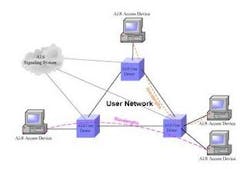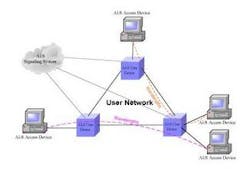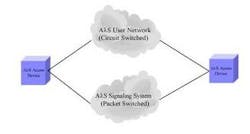AλS -- next-generation optical networking
A combination of packet and circuit switching in the optical domain results in an architecture that meets tomorrow's needs without discarding today's capabilities.
Victor Rychlicki
Rychtronix Mind Werkz
Network operators and service providers face the ongoing pain of operating multiple infrastructures to deliver multiple services; infrastructures are typically designed to supply or deliver a specific type of service, such as voice, Internet access, VPN data services, and video delivery. The trend today is to combine all of these services and more into a packet-based architecture. Packet-based networks make sense and give all services (voice, video, and data) not only a common format but a common infrastructure, such as an ATM or SONET transport network.
Yet the technology machine continues to churn out new and innovative ideas, forcing us to continually decide how to combine recent advances with existing technologies to achieve future success. There comes a point when we must let go of older ideas to make way for newer, more innovative ideas -- but this can be difficult, since we need to maintain operational support, or backwards compatibility, for older technology that is still in operation in many places. The key is to find the "happy medium" of technology, a place where old and new can meet for the benefit of all.
Application Lambda Switching (AλS) represents such a meeting point. It combines packet switching and circuit switching in the optical domain to improve network efficiency while maintaining support for current services and technology.
New technologies and old technologies
New technologies are evolving every day. Advances such as optical crossconnects (OCXs) for DWDM networks and optical amplification techniques such as Raman amplification promise real-time wavelength switching, frequency conversion, and bit-rate-independent amplification of wavelengths across multiple electro-magnetic spectrums. As technology progresses, so does the ability to distinguish between individual wavelengths. The more wavelengths we have at our disposal, the more use we can derive from our existing fiber optics. Today we can distinguish between more than 160 wavelengths; this number will, of course, increase with time.
We must decide what to do with these improvements once they are proven and mature. The easy answer is to look at how they can be integrated into existing technologies -- for example, the way we used WDM technology to increase fiber capacity while maintaining the same data and traffic flows that preceded the development of WDM. The not so easy answer is to use these new advancements to create something unique, something that correctly addresses all the issues we face when deciding how to combine services into a single network. An infrastructure that is truly flexible, won't nickel and dime us to death, has a virtually unlimited lifetime, is 100% backwards-compatible with all current and past optical technologies, and allows for simple multifunctional and low-cost access devices eliminates the issue of quality of service (QoS) and does not utilize revenue-generating bandwidth for operations, administration, and maintenance (OAM) functions.
The key to this new infrastructure lies in knowing how to use new technology advances in conjunction with existing, proven technologies. Let's start with what needs to stay and what needs to go. Ideas like packet switching, circuit switching, and DWDM have all been tremendously successful and work very well. We'll keep these. Topologies that cannot diagnose themselves, QoS problems, different technologies for the local and wide area, three- to five-year technological life spans, traffic management and congestion headaches, bandwidth limitations, complex access devices, and connectivity limitations are all things that need to go.
The resultant infrastructure should take the idea of being "data agnostic" one step further to being "information neutral." The difference between the two concepts is that data is digital, while information may be analog or digital. The new infrastructure thus should be able to handle analog as well as digital information.
The solution
AλS is such an infrastructure. AλS can best be described as an optical convergence of packet switching and circuit switching technologies. As with many communications systems, there are essentially two networks in operation within this individual infrastructure -- the network that transports users' data (the user network) and the network that manages the user network. The user network is nothing more than empty session-oriented circuit-switched wavelengths between communicating AλS access devices. These connections are created and maintained by the management network, known as the AλS Signaling System.
The infrastructure's inner workings are very similar to the way a typical telephone call is placed today in North America using Signaling System 7 (SS7). The AλS Signaling System is a packet network that runs in the background, out of sight and knowledge of the user. The signaling system accepts a request from a user to establish a connection to a given destination address, the same way the SS7 network takes the digits dialed (destination address) from your telephone and locates the destination telephone to establish a connection. Once the destination is located and a connection is established, the AλS Signaling System releases control of the newly established connection to the user to commence data communication, just as SS7 releases a circuit for voice communication once a voice call has been properly connected.
As stated previously, users make connections via a given set of wavelengths (lambdas). Every connection, whether it is to a Web site, another PC, etc., will be achieved by establishing one or more wavelengths between the user's device and the destination device. A user may be using many connections simultaneously. Each connection is simply an additional circuit-switched wavelength(s) from the source device, through the network, to its appropriate destination. It is free of other traffic, free of overhead, completely secure, and supports unlimited bandwidth.
A range of wavelengths from the electro-magnetic spectrum is initially reserved as "access-spectrum," and a larger, separate range or ranges is reserved as "core-spectrum." As grating and channel spacing technology develops and becomes more precise, more usable wavelengths in each range will become available. This methodology helps to reduce the total number of needed lambdas, set a standard for further development, and allow for modifications to core devices without the need for modifications to access devices, and vice-versa.
As an out-of-band packet-switched network, the AλS Signaling System will run on its own dedicated wavelength(s). Many transport technologies today utilize both a signaling system and a Layer 3 protocol. The AλS Signaling System is compatible with any Layer 3 protocol. Today this will most likely mean IP Version 4; tomorrow it will mean IP Version 6. The signaling system will interface with DNS or any other appropriate resolution method, and perform all other necessary Layer 3 functions as they apply to addressing. They are integrated into the AλS Signaling System and are therefore removed from the user's data path, again freeing the user network.
The benefits
The main difference in AλS versus data communication today is that all network overhead and processing is restricted to the AlS Signaling System. This removes all overhead and related resources from the user's data connection. The connection is thus free to be used in any manner. We take advantage of this today in an SS7-based network by using modems, fax machines, and other equipment to communicate across that connection. The same flexibility becomes possible with AλS because connections are free of other traffic and resources. Similarly, the lack of structure inside the user's AλS connections enables analog as well as digital communication.
These types of connections are possible via OCXs based on optical switching technologies such as thermo-optical, electro-optical, opto-mechanical, or liquid crystal switching, and developments in bit-rate-independent amplification such as Raman. These devices or combinations of these devices will have the ability to switch wavelengths and transport them long distances without the need of optical-to-electrical-to-optical (OEO) conversions for switching or regeneration. These devices do not care what type of information is contained in the wavelength, nor do they care about the speed at which the information is traveling. In essence, you create a path of light from point A to point B by reflecting it off of small mirrors (or other compatible technologies, such as bubbles) along the way. Because this is such a simple idea (reflecting light), it gives us an unprecedented amount of flexibility and capability.
The AλS core is capable of supporting any speed of communications because there is no OEO conversion. Access devices negotiate with each other via the AλS Signaling System for connection speed. As access devices are further developed and improved with newer features and higher speeds, the core will not require costly upgrades to support higher speeds.
AλS is 100% backwards-compatible with all current and previous optical transport technologies. This is achieved by placing all currently used wavelengths in the AλS access spectrum described above.
Access devices can be designed to be simpler in construction, require less intelligence, and be more flexible in connectivity. This is accomplished by employing the "Colon Quinoctogesimal 1924 Intelligent Addressing" algorithm. Access devices of today require additional intelligence to operate in current infrastructures, and are therefore more complex and expensive.
Another benefit of this new addressing algorithm is that it enables the entire re-creation of a network's infrastructure (core and access devices) starting with only one known address from any device in that infrastructure. Any device address can be decoded to reveal all connectivity information about the given device and all other devices to which it is attached. Utilizing the information revealed by one device address, other device connectivity and addresses can be requested and decoded. This process builds upon itself exponentially until the entire infrastructure has been accurately re-created, including access devices. This same algorithm is also used for fault management and connectivity troubleshooting without the aid of additional costly protocols and management systems.
As we can see, this new infrastructure offers many technical, as well as financial benefits. With proper utilization of the AλS Signaling System, an infrastructure can be created that will indefinitely outlast even the best-designed infrastructures of today without ever modifying, upgrading, or replacing any access devices regardless of age or software revision. This, of course, translates into lower cost and no downtime for carriers and customers.
The multiple benefits of the circuit-switched user network built upon individual session-oriented wavelengths are tremendous. One of the more significant of these benefits is the elimination of the ongoing technical battles for guaranteed QoS. This, in itself, eliminates ongoing traffic management and bandwidth limitation problems. The result is saved or recovered revenue, improved network performance, and customer satisfaction.
This simplified network design lowers cost and reveals a whole new realm of technical possibilities. The financial benefit of this simplified design is in keeping the cost of maintenance and long-term ownership much lower than with current transport technologies. Ongoing upgrades and modifications to the core of the network are significantly reduced and do not have to affect customer equipment or use at any point in the future. AλS transfers intelligence out of access devices and places it in the network's core infrastructure. This allows for another financial benefit, construction of simplified access devices that are less expensive and more reliable than their predecessors.
Victor Rychlicki is the president and lead researcher of Rychtronix Mind Werkz (Atlanta, GA). He can be reached via the company's Web site, www.rychtronix.com. He will be speaking about AlS at the TEC@Supercomm Conference hosted by the U.S. Telecom Association during this year's SuperComm in Atlanta, GA.


